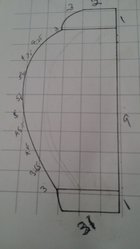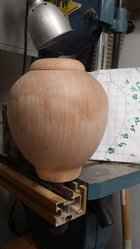Brad,
One of the things you've hit on is common with early turners. As they work to improve the look, the wood disappears and they end up with a shapely toothpick.
The skill needed here is taking light cuts. When you watch an expert do a demo, they'll go over the shape 8 times, refining the form until they're satisfied, but the size doesn't noticeably change. They just take off wispy shavings.
The skill starts with a freshly and well sharpened tool. Then you apply the bevel to the wood, gliding without cutting. Then the edge engages the wood, without pressure. As you get comfortable and more skillful, you'll be able to turn with softer hands--for now, consciously think about relaxing. Look at your knuckles--if they're white, you're too tense. Relax, soft hands, no pressure, no rush, just let the wood come to the tool.
I think Al Hockenbery's suggestion of spheres or eggs for practice is a good one, but you could do the same with a simply shaped small bowl. Use wood you don't care about, and turn a bunch of plain shapes, practicing thin cuts with a sharp tool producing wispy shavings. Do a bunch of them. Et Voila'.



